Practising Realistic Medicine: Chief Medical Officer for Scotland annual report
The Chief Medical Officer's third annual report on applying the personalised, patient-centred realistic medicine approach across Scotland.
Section 2 - A Summary Of The Health Of The Nation
This section will provide an overview of some of the key trends in Scotland’s health in recent years. It includes new data from the recent Scottish Burden of Disease Study and the Scottish Primary Care Information Resource ( SPIRE). It also highlights some of the ongoing priorities for Scotland, emerging challenges, public health success stories and frontiers for further development.
Trends In Mortality
Figure 14. Between 2001 and 2016, the overall death rate (labelled EASR) continued to decline – but this decline showed a plateau in recent years. Inequalities in death rates between socioeconomic groups (shown by the RII measure) increased over this period.
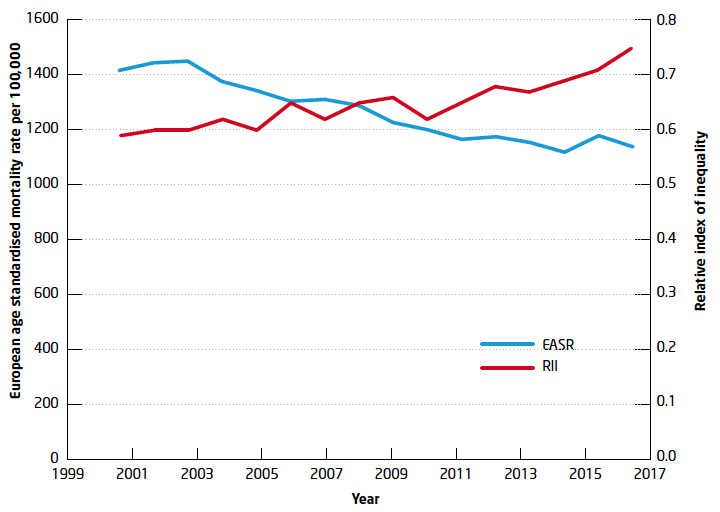
Source: National Records for Scotland
- There has been a long-term decline in death rates in Scotland, a decline which is most obvious when analyses take account of the rising average age of the population, as shown by the EASR measure in Figure 14.
- This decline in mortality has not in general been as rapid as the rest of the UK or other European countries.
- In addition, there was a marked slowing in this mortality decline from about 2011, and an upturn in mortality rates in 2015.
- Mortality rates fell again in 2016, but it is not clear that they have returned to the previous downwards trend.
- There is some evidence that the greatest slowing of mortality decline occurred among people living in the most deprived areas of Scotland. As shown in Figure 14, the relative index of inequality ( RII - a measure which summarises how “steep” the inequality gradient is across the socioeconomic spectrum) for mortality has increased between 1997 and 2016.
- A similar slowing in mortality decline has been seen in the rest of the UK and in many industrialised economies. [71]
- The reasons for this slowing in mortality decline are not completely clear. It is likely that influenza contributed at least partly to the rise observed in 2015, however the impact of austerity [72] and pressures on the health service [73,74] have also been suggested as possible explanations.
Burden Of Disease
Figure 15. This infographic from the Scottish Burden of Disease study illustrates what conditions we are living with, and dying from, in Scotland. The size of each “bubble” is proportionate to the rate of death and disability caused by that condition. You can view the image in more detail at: http://www.scotpho.org.uk/media/1450/sbod2015-bubbles.pdf
Burden of disease in Scotland, 2015
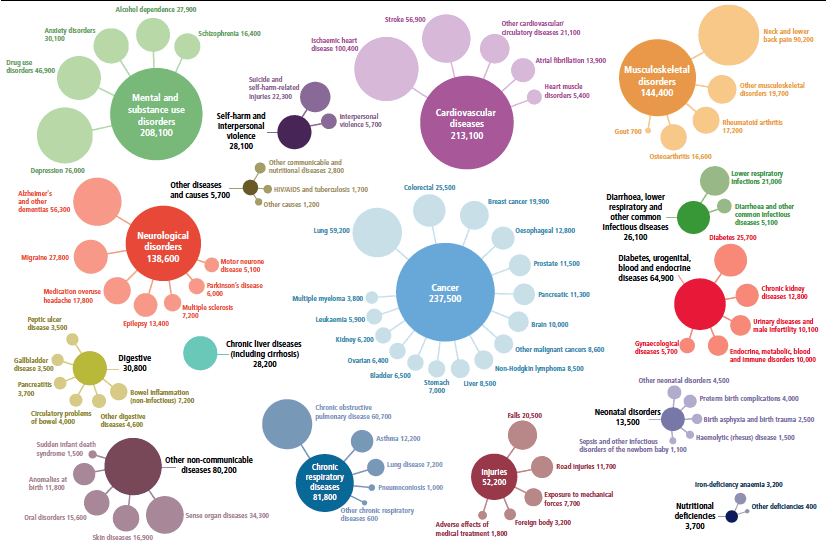
Note: Disability-adjusted life years rounded to the nearest 100. Scottish burden of disease study www.scotpho.org.uk/comparative-health/burden-of-disease/overview
- Efforts to understand the contributors to ill health are often based on mortality figures, but this neglects non-fatal conditions that may cause a substantial amount of suffering and disability.
- The Scottish Burden of Disease project has produced new estimates for the overall burden of disease in Scotland that combine figures on deaths with estimates of the numbers of people living with illness. [75] These estimates for the first time start to provide a clearer picture of the conditions that cause ill-health and mortality in Scotland.
- These estimates can be used to guide policy and set priorities and are also invaluable for starting to understand the most cost-effective approaches to improving health.
- Figure 15 shows estimates of the total burden of disease in Scotland (combining both death and disability) from the Scottish Burden of Disease ( SBoD) project. The large ovals show how this total burden is divided between major groups of disease. The smaller ovals show some of the individual conditions that make up the larger groupings. The figures are disability adjusted life years, which are explained in detail in the SBoD report.
- One important lesson from the project has been the variation in the quality of data between different disease areas; for example our data on cancer are much better than our data on musculoskeletal disease. This means that while all of these estimates are based on the best quality data available, some are more reliable than others. Work on enhancing the completeness and quality of data for future estimates is ongoing.
- Data such as that captured in Figure 15, alongside further data that will eventually become available in the Atlas of Variation, may in time inform different approaches about the way we prioritise the allocation of resources for maximum population health gain.
Figure 16. Rates of ill-health and premature mortality in Scotland show a clear “gradient” by socioeconomic circumstances, with greater socioeconomic deprivation associated with a greater burden of disease.
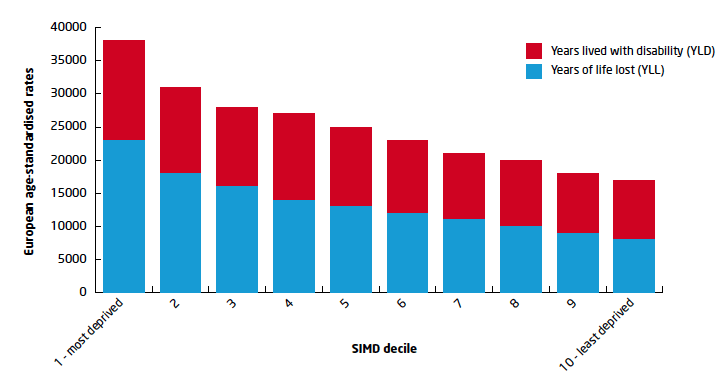
Source: Scottish Burden of Disease Study, 2015. SIMD 1 represents people living in the 10% most deprived areas in Scotland, whilst SIMD 10 represents people living in the 10% least deprived areas. Rates of both YLD and YLL are standardised for age using the European Standard Population, to account for differences in age structure between SIMD deciles. Results have been rounded to the closest thousand and may not exactly match other published figures.
- The results from the Scottish Burden of Disease study also show how the total burden of disease varies between people living in more deprived compared to less deprived areas of Scotland. The figure shows a steep socioeconomic gradient, both for years of life lost (mortality) and for years lived with disability.
Multi-Morbidity
Figure 17. These new data from the Scottish Primary Care Information Resource ( SPIRE) primary care project in Scotland illustrate that the prevalence of multi-morbidity (having more than one long-term health condition) increases with age. Among people 70 years and older, the majority are living with multiple long term conditions.
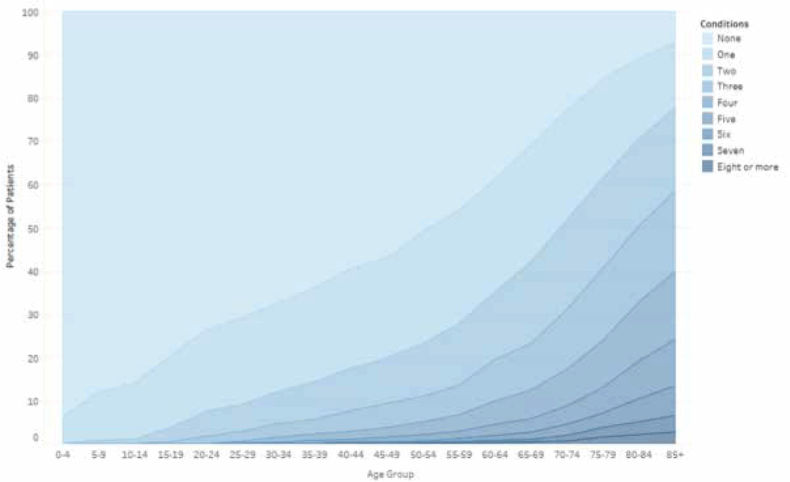
Source: Scottish Primary Care Information Resource
- These data are from a GP cluster (typically a group of 4-8 practices) in Dumfries and Galloway, collated through SPIRE - a new national resource to enable sharing of de-personalised primary care data, which is currently being rolled out across Scotland ( www.spire.scot). SPIRE allows us to look at multi-morbidity in this way by GP practice for the first time in Scotland.
- Figure 17 shows the proportion of people with multiple long-term conditions by age group: as you get older, the number of long term conditions (“multimorbidity”) you have tends to increase. However, this is not something that only affects older people: most people with multi-morbidity are under 65 years of age.
- Previous research has shown that multi-morbidity is associated with increased primary care consultation rates and polypharmacy, increased rates of unplanned hospital admission, and with lower quality of life. [76]
- The onset of multi-morbidity occurs on average 10-15 years earlier in people living in the most deprived areas of Scotland compared to the most affluent. People living in more deprived areas are also more likely to experience both physical and mental health conditions. [77]
- Information like this from SPIRE helps GPs and those in the wider primary care team improve quality of care for those with multiple long term conditions by, for example, reviewing the number of drugs they are on and targeting relevant support. It also helps in the planning of both primary and secondary healthcare services, informing decisions about workforce planning, resource allocation, and standard setting.
Health of the Nation Snapshots
This section builds on the overall picture described in the preceding section by picking out some more detailed snapshots of Scotland’s health - each of which serves to illustrate an ongoing challenge, emerging concern, or success story for Scotland’s health.
The intention of these snapshots is to provide a detailed insight into selected trends and to provoke discussion about how we might use these data to improve the health of our nation.
Type 2 Diabetes And Obesity
Figure 18. The prevalence of diabetes in Scotland has risen in recent years: most of this increase is due to type 2 diabetes.
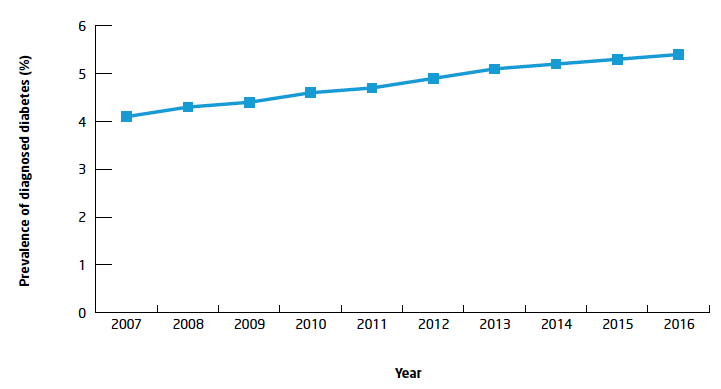
Source: Scottish Diabetes Survey 2016
- The prevalence of diagnosed diabetes in Scotland has risen in recent years [78] , from 4.1% in 2007 to 5.4% in 2016 (Figure 18). This may be an under-estimate of the true prevalence, as many people with diabetes go undiagnosed. Type 2 diabetes accounts for around 85-90% of cases of diabetes, and for the majority of the observed increase in prevalence over time.
- The main contributor to this upward trend is likely to be due to poor diet (specifically excess energy intake), low levels of physical activity and the resulting increase in levels of obesity. However, the ageing of the Scottish population, and better detection and increased survival of people with diabetes, are also likely to play a role.
- In 2016, 65% of Scottish adults were overweight, including 29% who were obese. [79]
- Obesity among adults has increased over time since 1995, though has been more or less stable in more recent years. [80] Since 1995, average BMI has increased across the whole population, but the biggest increases have been seen among those who already have a high BMI.
- For both adults and children, people living in the most deprived areas are more likely to be overweight or obese than people living in the least deprived areas. [81] Among children, the gap in obesity risk between the most and least deprived areas has widened over the last twenty years. [82]
- Rising levels of obesity in the population are caused by many factors, including changes in the food system, work, transport and the wider economy.
This “obesogenic environment” requires a population-level response to reduce obesity and associated harms, like type 2 diabetes. An updated strategy on diet and obesity will be published by the Scottish Government in 2018.
Inequalities In Mental Health
- Inequalities in mental health are persistent in Scotland and there is some evidence they have widened in recent years.
- Data from the Scottish Health Survey suggest that the prevalence of possible mental health problems has risen significantly among the poorest fifth of working-age adults over the last 15 years, whilst remaining relatively stable in other socioeconomic groups [83] ( Figure 19).
Figure 19. The percentage of working-age adults aged 16-64 with a GHQ-12 score of 4+ (indicating possible mental health problems), has increased in recent years among people from households in the lowest income quintile, but not among those in higher income households.
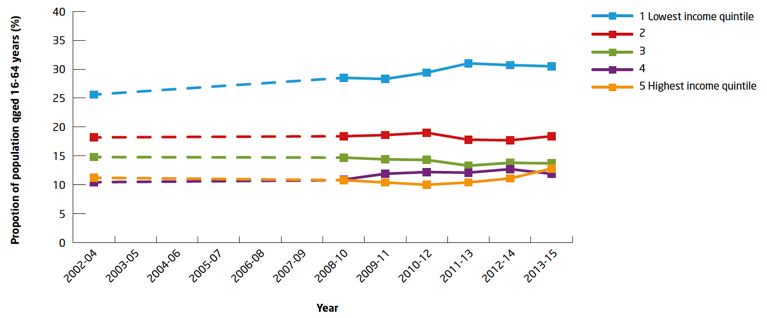
Source: Scottish Health Survey, 2016
- The Scottish Health Survey also shows that mental health among young adults has deteriorated since 2012, with the percentage with a possible mental health problem increasing from 13% to peak at 22% in 2015. In contrast, the proportion of the total working-age population with a possible mental health problem has remained fairly constant. This trend might partly be explained by an increasingly flexible and insecure labour market and recent changes to social security benefits, both of which have particularly affected young adults. [84]
- Since 2008, the Scottish Health Survey has collected data on the prevalence of anxiety among the adult population in Scotland. Examination of these data before and after the new welfare sanctions regime were introduced indicate a potential adverse impact on mental health (Figure 20). Among adults living in households in receipt of Job Seeker’s Allowance ( JSA) or Income Support ( IS) in 2008-11 (before the change), 19% had moderate to severe anxiety symptoms. Among those in a similar position in 2012-15 (after the change), the proportion was 28%. Adults living in households not receiving JSA/ IS, who were unlikely to be affected by these changes, showed only a minimal increase in anxiety symptoms over the same period.
- Together these findings suggest that mental health has worsened in recent years amongst those most affected by economic and labour market insecurity, and by welfare reform. This highlights the importance of a secure household income and good work to mental health and wellbeing. [85]
Figure 20. The prevalence of moderate to high anxiety has increased markedly in recent years among adults living in households receiving income from Income Support or Job Seeker’s Allowance, but only slightly among those who do not. This has been linked to changes in the benefit system.
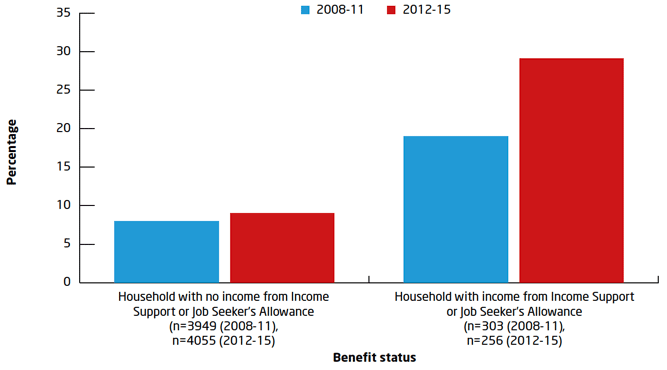
Source: Scottish Health Survey, 2016
Smoking
Smoking remains the biggest individual-level risk factor for morbidity and mortality in Scotland. Around 10,000 deaths (around a fifth of all deaths) and 120,000 hospital admissions in Scotland are smoking related. Smoking kills half of all regular smokers, and people in our least well-off communities are three times more likely to smoke than people in our best-off communities. This distribution and the high cost of smoking (averaging out at over £2,000 per year per smoker) has a significant on-going social, economic and health inequalities impact.
Scotland has made great progress in protecting people, especially children, from the harms of tobacco smoke and in smoking prevention – halving the rate of reported exposure among children to second hand smoke and reducing smoking levels among school-age children to an all-time low. Greater emphasis is now needed in encouraging more smokers to quit. The challenge is to get more smokers to seek support from NHS stop-smoking services - where their likelihood of success is more than doubled compared to trying to quit without support. Beyond encouraging more smokers into services we also need to ensure there is consistency of treatment options and consistency of advice available across Health Boards and their community pharmacies – 70% of all smokers using NHS services do so through community pharmacies.
Drug-Related Deaths
Figure 21. Deaths caused by the acute effects of drugs have risen in recent years, and in 2016 were at the highest level ever recorded in Scotland.
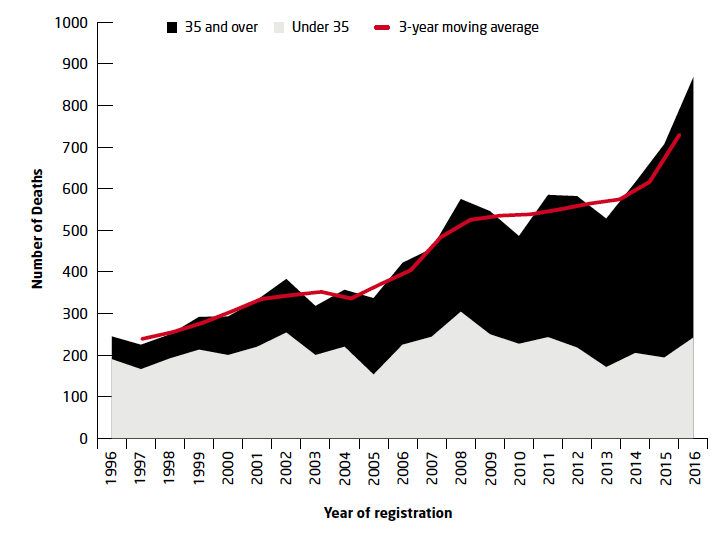
Source: National Records for Scotland
- In 2016, there were 867 drug related deaths in Scotland, 23% higher than in 2015 and the largest number ever recorded (Figure 21) [86] . (This definition relates only to deaths caused by acute effects of the drug itself, and does not include deaths from secondary complications or long-term conditions associated with drug use, such as thromboembolic disease (blood clots) or blood-borne viruses.)
- Numbers of drug related deaths have doubled in the past ten years (from 421 in 2006) ( Figure 21).
- There is a strong association between socioeconomic disadvantage and drug-related death: the most recent data available show that, between 2009 and 2014, 53% of deaths were among people living in the 20% most deprived neighbourhoods. [87]
- In 2016:
- Over two thirds (68%) of these deaths were in men.
- Heroin and/or morphine were implicated in, or potentially contributed to, the cause of 473 deaths (55%); one or more opiates or opioids (including heroin/morphine and methadone) were implicated in, or potentially contributed to, 765 deaths (88%).
- Most deaths involved more than one substance. In particular, benzodiazepines (for example diazepam, diclazepam and etizolam) were implicated in, or potentially contributed to, 426 deaths (49%).
- Scotland’s drug-death rate (relative to the number of people aged 15 to 64) is higher than those reported for all the EU countries (though there are issues of coding, coverage and under-reporting in some countries). Scotland’s drug-death rate per head of population is roughly two and a half times that of the UK as a whole.
- The average age of those who have died has increased over time, reflecting the known ageing profile of people with problem drug use ( Figure 21). This change in demographic profile has important implications for how health and social care services are developed and delivered for this population. [88] A refreshed strategy for drug and alcohol treatment in Scotland is due to be published by the Scottish Government in summer 2018.
Gambling
Figure 22. About 1% of the Scottish population over 16 years of age are estimated to be problem gamblers. The prevalence is highest among young men.
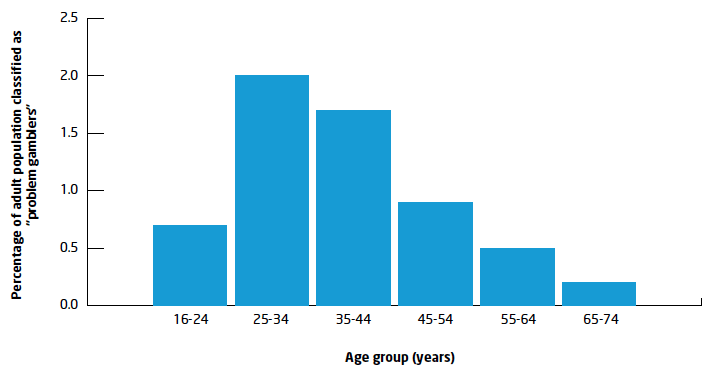
Source: Scottish Health Survey 2016. Estimates based on either Problem Gambling Severity Index ( PGSI) or Diagnostic and Statistical Manual of Mental Disorders of the American Psychiatric Association, Fourth Edition ( DSM-IV) scores
- In 2016 two thirds of Scottish adults reported that they had spent money on gambling within the previous 12 months. 89
- Many people gamble without experiencing adverse consequences, but others experience a range of health harms including depression, anxiety and poor physical health. People can also experience a range of other harms detrimental to health and wellbeing, such as financial difficulty and distress and relationship breakdown. Problem gambling is defined as “gambling to a degree which compromises, disrupts or damages family, personal or recreational pursuits”.
- In 2016 1 in 100 Scottish adults (1.0% of the adult population, or around 45,000 people) were problem gamblers, based on two standard measures [90] ( Figure 22). This rose to nearly one in 30 (3.4%) among men aged 25-34.
- A further 1.2% (around 54,000 adults) were likely to be at risk of gambling problems, based on a standard risk questionnaire.
- The prevalence of problem gambling in 2016 was highest among those in the lowest fifth of incomes and those in routine or manual occupations.
- There are no data available on gambling among children under 16 in Scotland: a recent survey in England and Wales found that 16% of 11-15 year olds reported having gambled in the previous week and that 75% had seen gambling advertising on TV. 91
Children’s Oral Health
Figure 23. The percentage P1 children in Scotland with no evidence of dental decay has risen substantially between 1988 and 2016.
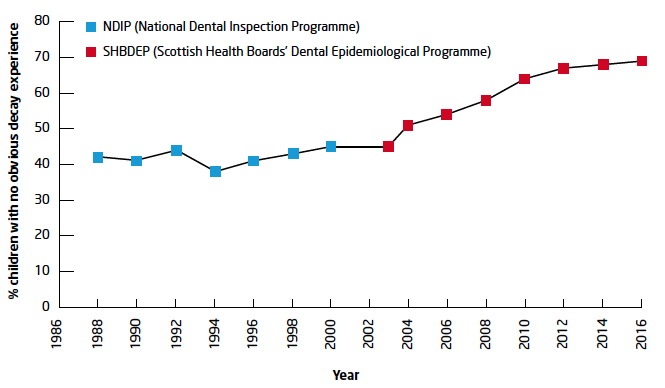
Source: National Dental Inspection Programme, 2016
- Children’s oral health in Scotland has dramatically improved over the last 15 years, in contrast to several other indicators of child health ( Fig 23).
- The reduction in dental decay has been shown to be the result of a national child oral health improvement programme [92] , which started in 2000 and was formally launched as “Childsmile” in 2005.
- Childsmile combines universal provision with targeted services for those most at risk, including: nursery toothbrushing and distribution of free toothbrushes and toothpaste; nursery and school fluoride varnish application; referral from health visitors to dental health support workers; child-friendly dental care delivered to children in dental practice. It involves multiple partners across health, education, and community settings – with robust evaluation. The success of the programme is dependent on the contributions of children, parents/carers, education staff, and dental teams.
- In particular, the supervised toothbrushing programme component of Childsmile, which is delivered to almost all nurseries in Scotland, has been shown to provide substantial savings to the NHS in reduced treatment costs [93] – the programme “broke even” within three years and by eight years the expected savings reached over two and a half times the costs.
- However, challenge of health inequalities remains – with 45% of five-year-olds from the most deprived communities ( SIMD 1) still experiencing obvious dental decay.
- Childsmile has been recognised as a world leading approach, with elements of the programme adopted internationally.
- The forthcoming national Oral Health Improvement Strategy will provide further opportunities to continue this work and address these challenges.
HPV Vaccination Programme
Figure 24. Women who have received a full course of the HPV vaccine show much lower rates of pre-cancerous changes in the cervix ( CIN) than their unvaccinated peers. Vaccination has also reduced socioeconomic inequalities in rates of pre-cancerous changes.
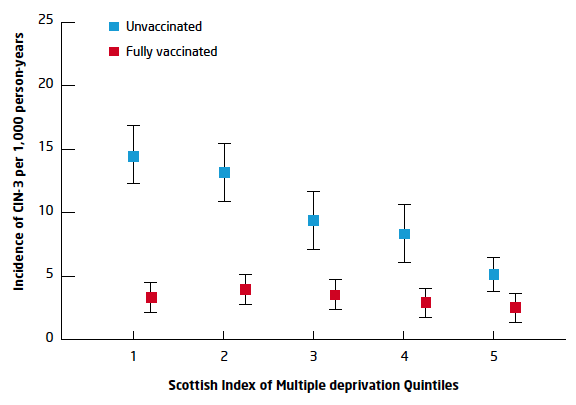
Source: Cameron et al (2017) [94] . Scottish Index of Multiple Deprivation ( SIMD) quintiles. SIMD 1 represents people living in the 20% most deprived areas in Scotland, whilst SIMD 5 represents people living in the 20% least deprived areas.
- Cervical cancer disproportionately affects women from lower socioeconomic backgrounds. A human papillomavirus ( HPV) vaccination programme was introduced in Scotland in 2008 to reduce infection with HPV and HPV-induced cervical cancer.
- HPV vaccine is offered to girls in secondary school with multiple opportunities for catch-up of missed doses, ensuring that uptake is high across all socioeconomic groups.
- By confidentially linking data on vaccination uptake with records from colposcopy clinics, it has been shown that women in Scotland who received the HPV vaccine had much lower rates of pre-cancerous changes in the cervix (cervical intra-epithelial neoplasia; CIN) [95] .
- The effect of the vaccine is especially marked among more deprived socioeconomic groups, who had previously had the highest burden of disease: among those vaccinated, the social gradient in the most severe pre-cancerous changes has largely disappeared ( Figure 24).
- These welcome results suggest that the HPV vaccine is helping to reduce inequalities in cervical cancer risk across Scotland. However, since the vaccine does not protect against all types of HPV, women who’ve been immunised still need to go for regular screening (smear test) from 25 years of age.
HIV Pre-Exposure Prophylaxis
- Pre-exposure prophylaxis ( PrEP) refers to the use of an anti-retroviral combination drug to prevent HIV infection. Several large international studies have demonstrated a substantial reduction in HIV transmission among those using PrEP. [96,97]
- PrEP became available on the NHS in Scotland in July 2017. PrEP is being prescribed to individuals at the highest risk of HIV infection as part of a comprehensive approach to HIV prevention, in tandem with regular HIV testing and safer sex practices.
- Men who have sex with men account for the majority of those eligible for PrEP in Scotland: estimates suggest that the number eligible is around 1700 (range 1500 to 1900). Based on this, it has been forecast that approximately 1000 people (range 880 to 1100) may come forward to commence PrEP in Scotland in the first 12 months of implementation. [98]
- The use of PrEP could transform the epidemiology of HIV infection in Scotland. Efforts are now underway by a national co-ordination group to ensure equity of access across Scotland, through work on education and awareness, clinical service provision, and monitoring and evaluation.
Whole-Genome Sequencing
- Whole Genome Sequencing ( WGS) is a technique that allows the entire DNA sequence for a particular person or organism to be determined. Recent advances have reduced the time and cost associated with WGS to a point where it is now becoming feasible in areas of clinical practice to inform diagnosis and to target treatment.
- The Scottish Government has invested in the Scottish Genomes Partnership – a collaboration between Scottish Universities and the NHS – to take forward genomic research programmes on rare diseases and cancers and to pilot, in association with Genomics England, Whole Genome Sequencing of patients with undiagnosed genetic conditions to help provide a diagnosis. Enrolment of Scottish patients and their families to defined clinical criteria began in May 2017, delivering on a commitment of the 2014 Scottish Government Rare Disease Implementation Plan “ It’s Not Rare To Have a Rare Disease” to explore whole genome sequencing for diagnosis of rare diseases. At the request of the CMO, the Scottish Science Advisory Council is providing advice and a report during 2018, on the development of genomic medicine in Scotland. This will inform future activities and a Scottish strategy for the organisation and delivery of genomic medicine.
- In the health protection setting, WGS can be used to more precisely identify infections and microbial contaminants and minimise much of the uncertainty associated with to the prevention and control of communicable disease. Since 2015, Health Protection Scotland and the Scottish Microbiology Reference Laboratories have worked closely to develop plans to implement and embed the WGS technology in the national public health microbiology services.
- Examples of the application of this technology include detection of the source of contaminated foods, improvements in the investigation of healthcare associated infection incidents, and analysis of antibiotic resistant “super bugs” that previously would have required much more time and resource to resolve.
- As a result of this preparatory work, WGS microbiology reference services for VTEC and Salmonella began in autumn 2017. Progress with the implementation and gains achieved through the introduction of pathogen genomics across the Scottish microbiology reference laboratories will be included in future annual reports.
Editorial Team
Dr Catriona Ingram,
Scottish Clinical Leadership Fellow
2017/18
Higher Trainee in Psychiatry
Craig Bell,
Realistic Medicine Team Leader,
Scottish Government
Dr Gregor Smith,
Deputy Chief Medical Officer,
Scottish Government
Dr Helen Mackie,
Realistic Medicine Clinical Advisor,
Scottish Government
Dr Gillian Paterson,
ST5 Forensic Psychiatry,
Scottish Clinical Leadership Fellow
2016/17
Dr Christine Gregson,
ST7 Infectious Diseases and General
Medicine, Scottish Clinical Leadership
Fellow 2015/16
Contributors
Dr Emily Tweed, Clinical Lecturer and Honorary Specialty Registrar in Public Health, University of Glasgow and NHS Greater Glasgow and Clyde
Dr Lesley Curry; Scottish Clinical Leadership Fellow, NHS Education for Scotland and Scottish Government Workforce.
Dr David Caesar; National Clinical Advisor to the Chief Medical Officer; Scottish Government.
Blythe Robertson; Health Literacy Lead; Scottish Government.
Dr Belinda Hacking; Consultant Clinical Psychologist; Head of Adult Psychology NHS Lothian.
Professor Craig White; Divisional Clinical Lead; Healthcare Quality and Improvement Directorate, Scottish Government.
Mary Hucker; Realistic Medicine Senior Policy Manager, Scottish Government.
Dr Neil Patel; Consultant Neonatologist, Royal Hospital for Children, Glasgow.
Professor Richard Osborne; Director of a Health Systems Improvement Unit a WHO Collaborative Centre for Health Literacy; Deakin University.
Professor Emma Cave; Professor of Healthcare Law, Durham Law School.
Professor Margaret Brazier; Professor of Law, University of Manchester’s School of Law.
Rosemary Agnew; Scottish Public Services Ombudsman.
Dr Margaret Hannah, Director of Public Health, NHS Fife.
Dr Colin Fischbacher, Clinical Director for Information Services, Information Services Division ( ISD), NHS National Services Scotland.
Professor John Kinsella, Chair Scottish Intercollegiate Guidelines Network.
Professor Stewart Mercer, Director Scottish School of Primary Care.
Dr Ann Wales, Programme Manager, Knowledge and Decision Support, eHealth, Scottish Government.
Contact
There is a problem
Thanks for your feedback